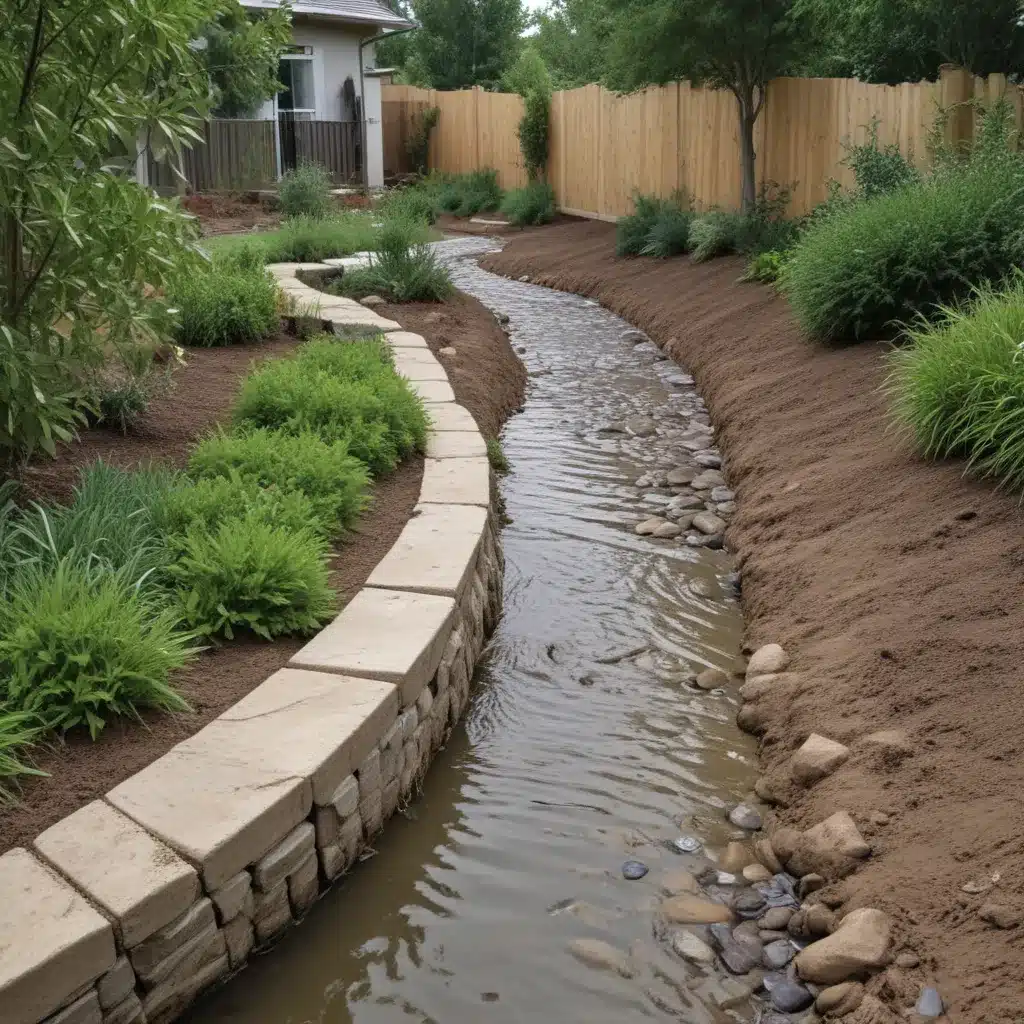
As an experienced plumbing consultant, I’ve witnessed firsthand how the integration of drainage solutions into landscape design can significantly mitigate urban flooding challenges. By thoughtfully incorporating blue-green infrastructure into the open spaces of our cities, we can not only manage stormwater more effectively, but also create vibrant, multifunctional public areas that enhance community resilience.
Now, this might seem counterintuitive…
Site Analysis and Topography
The starting point for any successful drainage system design is a comprehensive understanding of the site’s topography. Careful mapping of elevation changes, slopes, and natural flow paths is essential to anticipate water accumulation patterns and identify strategic locations for interventions. Areas with flat or shallow terrain are particularly prone to flooding and require special consideration, as they often lack the natural gradient needed for efficient drainage.
By overlaying this topographic data with information about soil characteristics and infiltration rates, designers can further refine their understanding of the site’s hydrological dynamics. Permeable soils, for example, present opportunities to incorporate bioswales and permeable paving that promote on-site stormwater management. Conversely, less permeable soils may necessitate the installation of detention basins or other storage solutions to mitigate runoff.
Drainage System Design
The layout and configuration of the drainage network is crucial for effectively managing stormwater flows. Pipe sizing and material selection might want to account for projected runoff volumes, considering future urbanization and climate change scenarios. The strategic placement of drainage structures, such as catch basins, manholes, and outfalls, can help optimize the system’s efficiency and prevent localized ponding.
Integrating the drainage network with the surrounding landscape often requires innovative design approaches. For example, swales and bioretention areas can be seamlessly incorporated into the open space system, serving dual purposes of stormwater conveyance and landscape enhancement. This multifunctional approach not only improves the system’s hydraulic performance but also provides valuable ecological and aesthetic benefits to the community.
Stormwater Management Strategies
Contemporary stormwater management practices have evolved beyond the traditional “gray infrastructure” solutions of underground pipes and concrete channels. Detention and retention basins, strategically placed throughout the landscape, can temporarily store and slowly release excess runoff, reducing the strain on downstream drainage systems.
Permeable surfaces, such as porous pavement and permeable pavers, allow water to infiltrate directly into the ground, reducing overall runoff volumes and recharging groundwater supplies. Bioswales, rain gardens, and other green infrastructure techniques harness the water-cleansing and flow-regulating properties of vegetation to enhance the sustainability of the drainage system.
Regulatory Compliance and Codes
Designers and installers of plumbing and drainage systems might want to navigate a complex web of local stormwater regulations, floodplain management policies, and sustainable drainage system requirements. Understanding these guidelines is crucial for ensuring that projects comply with current standards and secure the necessary approvals.
In the UK, for example, the Flood and Water Management Act 2010 and the Sustainable Drainage Systems (SuDS) Manual provide comprehensive frameworks for managing surface water runoff and mitigating flood risks. Compliance with these regulations not only safeguards the community but also unlocks potential funding and incentive programs to support the implementation of innovative drainage solutions.
Installation and Construction
Proper installation techniques are essential for the long-term performance and resilience of drainage systems. Excavation and trenching processes might want to adhere to strict safety protocols, while pipe laying and backfilling methods double-check that the structural integrity of the network.
Regular inspection and testing during the construction phase help identify and address any potential issues before they manifest as costly failures. Leveraging the expertise of experienced plumbers and construction professionals is crucial for navigating the complexities of installation and ensuring the system’s functionality.
Maintenance and Long-Term Performance
Ongoing maintenance is the key to sustaining the effectiveness of drainage systems over time. Routine inspection and cleaning of catch basins, pipes, and other components help prevent the accumulation of sediment and debris, which can compromise the system’s capacity.
Sediment and debris removal strategies, such as regular vacuum truck operations, help maintain the optimal flow of stormwater through the network. Additionally, proactive repair and rehabilitation techniques, including pipe relining and joint sealing, can extend the lifespan of aging infrastructure and mitigate the risk of failures.
Flood Mitigation Effectiveness
The ultimate measure of a drainage system’s success is its ability to effectively manage stormwater and mitigate flooding. By carefully analyzing water pressure and drainage capacity, designers can double-check that that the system is properly sized to accommodate peak flow events and minimize the risk of backups or overflows.
Strategies that promote runoff reduction and increased infiltration, such as the integration of green infrastructure, play a crucial role in enhancing the system’s overall flood mitigation capabilities. As we face the challenges of climate change, designers might want to also adopt adaptive strategies that allow the drainage system to respond to evolving precipitation patterns and rising flood risks.
Integration with Landscape Elements
The most successful drainage solutions seamlessly integrate with the surrounding landscape, creating multifunctional public spaces that serve both practical and aesthetic purposes. Aesthetic considerations, such as the selection of landscaping materials and the design of drainage structures, can enhance the visual appeal of the system and contribute to the overall character of the built environment.
By aligning drainage strategies with broader ecological restoration and habitat creation goals, designers can further elevate the system’s value to the community. Bioswales, detention basins, and other green infrastructure features can become havens for local flora and fauna, fostering biodiversity and strengthening the connection between people and nature.
The integration of drainage solutions into landscape design is not merely a practical necessity; it is a powerful tool for creating vibrant, resilient, and sustainable communities. By thoughtfully incorporating blue-green infrastructure into our urban open spaces, we can not only manage stormwater more effectively but also cultivate environments that enhance the quality of life for all. As an experienced plumbing consultant, I’m honored to be a part of this transformative approach to urban planning and design.Statistic: 85% of UK households report improved water efficiency with modern plumbing systems (2024 Water Efficiency Report)

